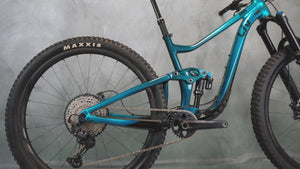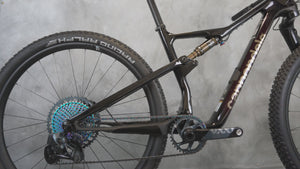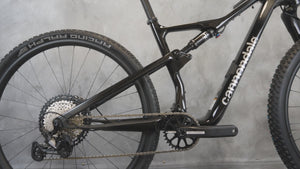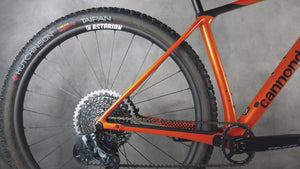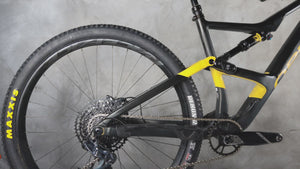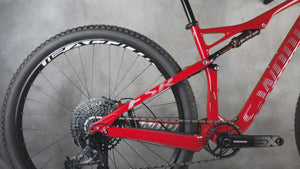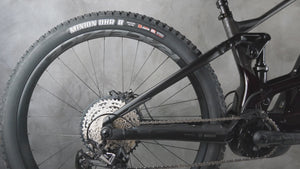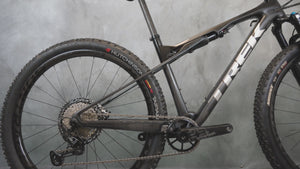SRAM vs Shimano MTB groups: comparison and analysis
In this Article
Published on May 25, 2023
As for road bike groupsets, Shimano and SRAM are the market leaders in mountain bike components. You probably know these 2 brands by name, and know that in terms of reliability and quality, they are equivalent. But do you know in detail the different ranges of each brand? Deore, Tirage, XT, XTR, Eagle... the ranges have specific names for MTB, different from road and gravel. If we add the terms to differentiate between electric and mechanical groups, we end up getting lost and not understanding anything 😵💫
And yet, knowing the different ranges of these components (rear derailleur, brakes, etc.) is essential when you buy a bike, especially when you buy it second hand, because it allows you to see if the price of the bike is justified or not.
Don't worry about it, The Cyclist House is here to enlighten you on the different SRAM and Shimano groupsets and help you make the right choice.

What is a bike group?
We explained it in our article on SRAM vs Shimano road groupsets which we invite you to read if you want to know everything in detail. For those who want to get to the point: a groupset is the set of components that make up the transmission system: crankset, chain, derailleurs.
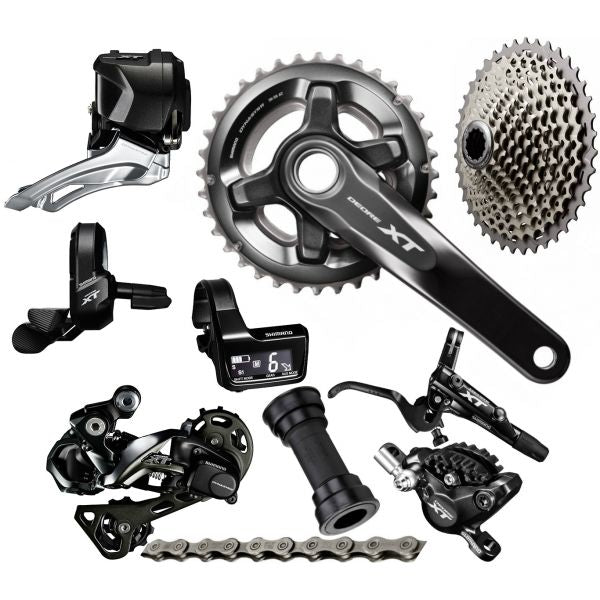
What are the differences between a mountainbike group and a road group?
In reality, it is quite similar. The most notable differences are:
- the shifters: the road models are only compatible with road or gravel dropbars while the MTB shifters are mounted on flat bars
- the front derailleur: currently almost all MTB have 1x groups and thus don't need a front derailleur
- the size of the cassette: larger for the mountainbike than for the road, from 40 to 46 teeth for the largest sprocket in general
- the size of the front chainring: smaller for MTB
- the materials used: MTB groupsets are more resistant to face a practice with a lot of shocks
What are the ranges by brand ?
As for the road components, both brands have models ranging from entry level to ultra high end. To help you find your way around, we compare them model by model in the tables below:
Entry level
|
Shimano |
SRAM |
|
Deore |
NX or SX |
|
SLX |
GX Eagle mechanical |
Mid-range
|
Shimano |
SRAM |
|
XT |
X01 Eagle mechanical |
Top of the range
|
Shimano |
SRAM |
|
XTR |
XX1 Eagle mechanical |
For downhill and freeride, Shimano offers specific groupsets: Saint.
Specificities at SRAM
| Entry level |
GX Eagle AXS GX T-Type AXS |
| Mid-range |
X01 Eagle AXS X0 T-Type AXS |
| Top of the range |
XX1 Eagle AXS XX T-Type AXS |
As you may have noticed, the SRAM range is much more extensive than Shimano's for MTB, as they offer electronic transmissions (AXS). Electronic transmissions are distinguished into 2 categories: Eagle AXS, which is the "older" technology from SRAM, and the T-Type AXS, which is the latest technology in terms of MTB transmission.
To make this clearer for you, here are some explanations of these differences:
Eagle:
Mechanical transmission: Uses cables and housings to change gears.
Installation: Installs on standard derailleur hangers, so on all modern MTBs. Requires a cable and housings.
Price range: From entry-level (SX, NX Eagle) to high-end (XX1 Eagle), for riders looking for the reliability, robustness, and cost-effectiveness of mechanical.
Eagle AXS:
Wireless electronic transmission: Uses AXS technology for precise and fast electronic gear changes.
Installation: Installs on standard derailleur hangers, so on all modern MTBs. No cables or housings, only a battery for the rear derailleur.
Customization: Via the SRAM AXS app to adjust gear change preferences.
Range: From mid-range (GX Eagle AXS) to high-end (XX1 Eagle AXS) for riders seeking the comfort and simplicity of electronic transmission maintenance as well as the speed of gear changes.
Eagle T-Type:
Advanced technology: Incorporates the latest innovations to improve durability and transmission performance.
Installation: Requires a UDH (Universal Derailleur Hanger) compatible frame.
Electronic transmission: AXS technology for wireless gear changes.
Range: from mid-range (GX T-Type) to high-end (XX T-Type) Designed for bikes and riders seeking the latest advances in MTB transmission technology. And the comfort of electronics with virtually unbreakable derailleurs.
In summary, Eagle is the traditional mechanical version, Eagle AXS is the wireless electronic version for increased precision and reduced maintenance, and Eagle T-Type is an advanced and specific version integrating the latest SRAM technologies for optimal performance.
Which MTB group range should you choose?
To know which range to choose, you should ask yourself 3 questions:
1. What type of cyclist are you?
If you have read our article on SRAM vs Shimano road groupsets, you already know which group to choose according to your riding style. If not, we'll put it back below 👇
Entry level for beginners. If you are a beginner and can afford it, we suggest you take a look at the mid-range.
Mid-range for advanced cyclists. Reliable, solid and accurate, the best value for money for regular use.
Top of the range to touch the equipment of the pros. Speed, ergonomics, design.
Ultra high-end for competitors (and lovers of beautiful mechanics 😊). The smoothest and lightest equipment, simply. Irreproachable.
2. What is your budget?
This criterion is specific to each one, it is up to you to decide what investment to make according to what you can afford and your practice. We will detail the price of the different groups below.
3. What type of MTB rider are you?
However, the criteria to consider are weight, durability, and gear change efficiency. In XC, lighter transmissions are favored, such as the XX or XX1 from Sram or the XTR from Shimano, whereas in Enduro, one would rather opt for GX or X0 to limit the more fragile carbon components. However, the highest-end transmissions, which are primarily used, can also be used in Enduro, designed for this practice as well, but in case of breakage, their replacement is more costly.
Need help to choose the type of mountainbike that suits you best? Our article will help you to see more clearly.
What are the differences between the brands?
We will compare the groups of equivalent quality from both brands according to several criteria: materials, price, weight, durability and compatibility.
1. Materials and technology
The electric transmission system. Shimano groups keep the same naming as road groups: Di2 (for Digital Integrated Intelligence🤓). SRAM has a specific naming for MTB electronic transmissions: Eagle.
Disc brake fluid: DOT for SRAM and mineral for Shimano.
2. Price
Entry level: Prices vary but you can find the various parts of the groupsets (rollers, derailleur, etc) for less than 30€. So you can get by for 250-300€ in total.
Mid-range: At Shimano for the Deore and SLX, you're looking at around 300-500€.
At Sram, for the GX and the NX, you should also count a little more than 300€.
High end: For the XT at Shimano or the X01 at SRAM, the average price is more like 500€ or more.
Ultra high end: as you can imagine for the ultra high-end we will be above 650€.
NB: we give you price ranges to give you an idea, these prices may vary depending on the years and distributors.
3. Weight
It would be time consuming to compare the weights of each groupset because to do it right you would have to compare the weight of each component.
We simply advise you to pay attention to the weight according to your practice. For example, if you compete in XC and you want to be as good as possible, then the weight of the groupset will play an important role.
If you practice Trail or Enduro, you should choose more resistent materials that will be heavier by design.
4. Durability
For us, the notion of durability calls above all for maintenance: whatever the type, a transmission must be adjusted and maintained. To learn more, please refer to our road bike maintenance guide.
5. Compatibility
In terms of compatibility, with Shimano: all groups are compatible as long as you stick to the same number of speeds. However, with SRAM, you need to respect the generation (Eagle and T-Type) to have the appropriate chains, cassettes, and cranksets. On the other hand, the AXS shifters and derailleurs are cross-compatible regardless of the generation.
Conclusion
Groupsets have no secrets for you now 🤫 Even if it remains a very complex subject you know the different ranges of SRAM and Shimano brands. You can now partly understand the price of some bikes. We have no preference for one brand or another, we let you test and make your own opinion.
Did you like this article? Find those dedicated to the stems of telescopic saddle stems and the suspended forks to learn more about all mountain bike components.
We also recommend the essential for any MTB owner who wants to take care of his equipment to preserve its value as long as possible: the complete maintenance guide for your MTB.






















